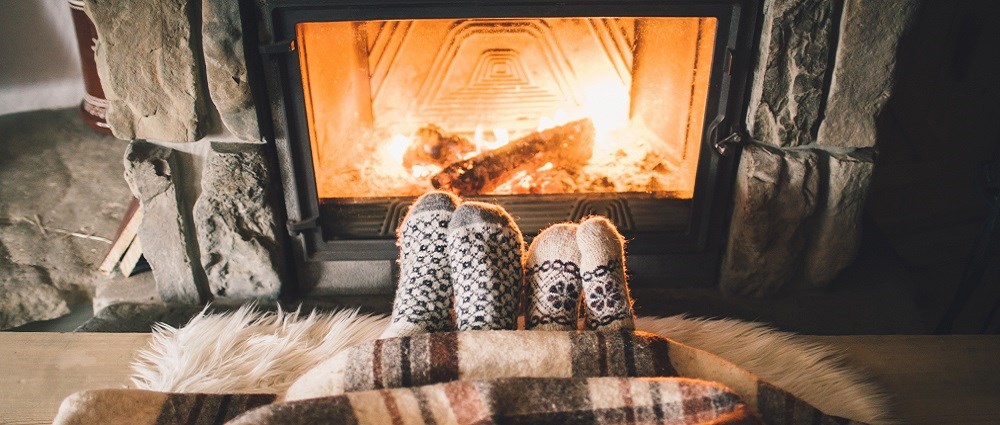Warming your home safely this winter
Very few people admit to liking cold weather. There are exceptions, of course, but many of us prefer to be inside our cosy homes when it’s cold, wet or windy outside. And this is particularly true for older people, who are more vulnerable to cold temperatures.
The charity, Age UK, says that one older person dies every seven minutes from the cold1. Chilly homes pose a health risk as low temperatures make people more susceptible to flu, breathing problems and elevated blood pressure. A body adjusting more slowly to the temperature difference between the outside and indoors can contribute to increased heart attacks in the winter2.
Age UK recommends that bedrooms should be maintained at 18 degrees centigrade (64 degrees Fahrenheit) and living rooms should be kept at 21 degrees centigrade (70 degrees Fahrenheit) in order to stay optimally warm.
Some older people are eligible for various government grants to help3 with their winter energy bills. These include the one-off Winter Fuel Payment for anyone born on or before January 5th 1953, one-off Cold Weather Payments for people on specific benefits, or the Warm Home Discount Scheme of £140.
Typical primary sources of heat
Most people in the UK, whether they're living on their own, as a couple or with a large family, will warm their homes safely this winter by conventional means such as:
- Central heating systems comprising of a boiler, radiators and typically a thermostat allowing the occupant to alter the temperature to suit their needs. Some energy providers now even provide smartphone apps for the remote control of central heating, so customers can make sure their property is warm when they return. Central heating warms a home quite quickly, but replacement boilers are relatively expensive and heavy usage can make monthly bills costly.
- Electric storage heaters are the second-most common source of heat for UK homes without central heating, according to the Energy Saving Trust4. They operate by heating up using cheaper overnight off-peak electricity, and then radiating the heat in the daytime. Electric storage heating is often found to be more expensive. Plus, it doesn’t give the user as much control as radiators or wall thermostats, and emits more CO2.
Secondary heat sources
Some householders with central heating or electric storage heaters may need to rely on supplementary heat sources during cold winters, particularly if they're older and feel the cold more readily. Typical means of heating one particular room include:
- Portable heaters which can be electric and use fans, oil, convection or panels, or be fuelled by gas or halogen. More expensive and best relied on as a backup measure, there's also a fire risk associated with portable heaters, especially if they’re left unattended. Between 2009/10 and 2014, they were responsible for 73 deaths and 3,800 fires in the UK5.
- Wood burning, multi-fuel and wood pellet stoves are trendy at the moment, forming attractive focal points and, of course, heat sources, in homes throughout the country. Suitability depends on each property, with stoves typically throwing out a lot of heat, but you need storage space for the wood logs. Ash is also produced, which will need removing. Wood pellet stoves are commonly more expensive, but work more efficiently6.
- Open fires look inviting, particularly in larger properties and can generate substantial heat. Nevertheless, they require a reliable source of fuel and can pose a safety risk for pets and young children who may come into contact with the flames.
- Gas fires are very popular secondary heat sources in homes across the UK and have a stylish appearance without the need to physically fuel and clean them. It’s important to get them regularly serviced, though, as in excess of 260 people aged 65 and over become poorly each year due to faulty domestic gas appliances. The Health and Safety Executive also reports that half of the gas fires it checked were found to be dangerous7.
- Electric blankets are a fantastic way of making sure your bed is toasty, but they should ideally be replaced every 10 years. Safety precautions should be also be taken, such as not getting them wet and only leaving them on overnight if thermostatic controls are fitted8.
Alternative and unusual ways to warm your home safely this winter
Buying festive food and gifts over the Christmans period means many people have to be extra careful with their domestic bills. So here are some handy alternative suggestions to help to keep your home warm:
- Close the curtains when it’s dark, particularly if they’re a thick quality, as this helps keep heat inside. Open them again when it’s light, to let the sun help warm your home up
- Buy a chimney balloon, which prevents cold air from entering via an unused chimney, and at the same time, stops heat escaping up the hole
- Identify and reduce draughts, such as around letterboxes, keyholes and doors9
- Radiators work better if they’re not hidden by furniture, such as dressers or settees
- Doors should be closed if a room isn’t being used, to keep the heat where it’s wanted
- Bare floorboards can be partly covered by cheap rugs or throws
- Tin foil can be put on the walls behind radiators, so that otherwise lost heat is reflected back into the room10
If you don’t currently pay for a boiler servicing and repair plan, or intend to use portable heaters, it’s always a good idea to read through your home insurance policy documentation to remind yourself what is and isn’t covered, along with your safety responsibilities. By planning and acting in advance, rearranging furniture and taking other steps to make your property more efficient, it’s possible to warm your home safely in the winter, without it being overly expensive.
Sources:
- http://www.ageuk.org.uk/health-wellbeing/keeping-your-body-healthy/winter-wrapped-up/winter-health-resources/
- http://www.ageuk.org.uk/health-wellbeing/keeping-your-body-healthy/winter-wrapped-up/keeping-warm/
- https://www.citizensadvice.org.uk/consumer/energy/energy-supply/get-help-paying-your-bills/grants-and-benefits-to-help-you-pay-your-energy-bills/
- http://www.energysavingtrust.org.uk/home-energy-efficiency/heating-and-hot-water
- http://ageuklondonopinionexchange.org.uk/playing-with-fire-older-people-at-risk-from-incorrect-use-of-portable-heaters/
- http://www.which.co.uk/reviews/wood-burning-stoves/article/wood-burning-stoves/multi-fuel-stoves-vs-wood-burning-stoves
- http://www.express.co.uk/news/uk/711943/Action-to-cut-toll-of-deadly-gas-fires
- http://www.fireservice.co.uk/safety/electric-blankets
- http://www.bbc.co.uk/news/magazine-24757144
- http://www.mirror.co.uk/money/personal-finance/10-ways-keep-warm-save-4602593

